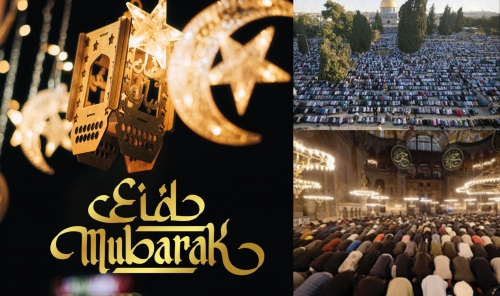Eid al-Fitr: A Celebration of Faith, Gratitude, and Togetherness
TDT | Agencies
Email : editor@newsofbahrain.com
Muslims worldwide mark the end of Ramadan with prayers, feasts, charity, and family gatherings
After a month of fasting, prayer, and self-reflection during Ramadan, Muslims around the world welcome Eid al-Fitr, the "Festival of Breaking the Fast." This joyous occasion, one of the most significant celebrations in Islam, marks the successful completion of the sacred month and serves as a time for gratitude, generosity, and togetherness. Families and communities gather to offer prayers, share meals, and strengthen social bonds, making Eid a deeply cherished event.
Moon Sighting and the Start of Eid
The arrival of Eid al-Fitr is eagerly anticipated, with its official start determined by the sighting of the new moon. Since the Islamic calendar follows a lunar system, the exact date of Eid varies across different countries. The sighting of the crescent moon signals the end of Ramadan and the beginning of three days of festivities, during which fasting is prohibited to emphasize the importance of celebration and gratitude.
Charity and Acts of Giving
Before heading to the mosque for the special Eid prayer, Muslims fulfill an essential obligation: Zakat al-Fitr, a charitable donation meant to ensure that those in need can also partake in the celebrations. This donation, given in the form of food or money, must be distributed before the Eid prayer, highlighting the festival's core value of generosity. Additionally, many Muslims continue acts of kindness by visiting the sick, helping the less fortunate, and making donations to charities.
Eid Prayer and Greetings
On the morning of Eid, Muslims gather in mosques, open fields, or prayer grounds to perform Salat al-Eid, a special communal prayer consisting of two rak‘ahs (units of prayer) with extra Takbirs (proclamations of “Allahu Akbar”). Following the prayer, the Khutbah (sermon) reminds worshippers of the significance of gratitude, unity, and faith. As the congregation disperses, the air is filled with warm greetings of “Eid Mubarak” and “Eid Sa‘id,” as people exchange blessings and embrace one another.
Traditional Attire and Festive Meals
Dressing in new or special clothing is a long-standing tradition associated with Eid. Many people wear traditional outfits that reflect their cultural heritage, while others opt for their finest attire as a way to express gratitude and joy. After the morning prayers, families return home to indulge in lavish meals and sweet treats. Special dishes such as kahk (cookies), biryani, and sheer khurma (a dessert made with milk and vermicelli) are prepared and shared with loved ones and neighbors, reinforcing the spirit of community.
Family Gatherings and Eidiya
Eid is a time for strengthening relationships, and visiting family and friends is a key part of the celebration. Children, in particular, look forward to receiving Eidiya, a cherished tradition in which elders give them money as a token of love and blessing. The joyous reunions are filled with laughter, storytelling, and shared meals, creating memories that last a lifetime.
Festivities and Traditions
While Eid is primarily a religious festival, it is also marked by various cultural festivities. In many countries, public celebrations include fireworks displays, fairs, and cultural performances. Families take children to amusement parks, beaches, or recreational areas, ensuring that the holiday is not only spiritually meaningful but also full of fun and entertainment.
Time for Reflection and Gratitude
Despite the joyous nature of Eid, it is also a moment of deep reflection. Many Muslims use the occasion to express gratitude for the strength to complete Ramadan and seek guidance for the future. Some continue with extra prayers, Quran recitations, and acts of worship, carrying forward the spiritual discipline they developed during the holy month.
Related Posts

